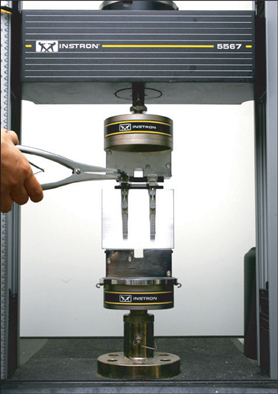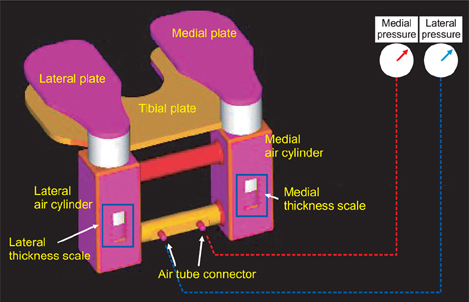Clin Orthop Surg.
2012 Sep;4(3):188-192. 10.4055/cios.2012.4.3.188.
Development of a Pneumatic Tensioning Device for Gap Measurement during Total Knee Arthroplasty
- Affiliations
-
- 1Department of Anatomy, Catholic Institute for Applied Anatomy, The Catholic University of Korea School of Medicine, Seoul, Korea.
- 2Department of Orthopaedic Surgery, The Catholic University of Korea School of Medicine, Seoul, Korea. iy1000@catholic.ac.kr
- KMID: 1392980
- DOI: http://doi.org/10.4055/cios.2012.4.3.188
Abstract
- BACKGROUND
Despite the importance of soft tissue balancing during total knee arthroplasty (TKA), all estimating techniques are dependent on a surgeon's manual distraction force or subjective feeling based on experience. We developed a new device for dynamic gap balancing, which can offer constant load to the gap between the femur and tibia, using pneumatic pressure during range of motion.
METHODS
To determine the amount of distraction force for the new device, 3 experienced surgeons' manual distraction force was measured using a conventional spreader. A new device called the consistent load pneumatic tensor was developed on the basis of the biomechanical tests. Reliability testing for the new device was performed using 5 cadaveric knees by the same surgeons. Intraclass correlation coefficients (ICCs) were calculated.
RESULTS
The distraction force applied to the new pneumatic tensioning device was determined to be 150 N. The interobserver reliability was very good for the newly tested spreader device with ICCs between 0.828 and 0.881.
CONCLUSIONS
The new pneumatic tensioning device can enable us to properly evaluate the soft tissue balance throughout the range of motion during TKA with acceptable reproducibility.
MeSH Terms
Figure
Reference
-
1. Mihalko WM, Saleh KJ, Krackow KA, Whiteside LA. Soft-tissue balancing during total knee arthroplasty in the varus knee. J Am Acad Orthop Surg. 2009. 17(12):766–774.
Article2. Peters CL. Soft-tissue balancing in primary total knee arthroplasty. Instr Course Lect. 2006. 55:413–417.3. Winemaker MJ. Perfect balance in total knee arthroplasty: the elusive compromise. J Arthroplasty. 2002. 17(1):2–10.
Article4. D'Lima DD, Patil S, Steklov N, Colwell CW Jr. An ABJS best paper: dynamic intraoperative ligament balancing for total knee arthroplasty. Clin Orthop Relat Res. 2007. 463:208–212.5. Swany MR, Scott RD. Posterior polyethylene wear in posterior cruciate ligament-retaining total knee arthroplasty: a case study. J Arthroplasty. 1993. 8(4):439–446.
Article6. Pagnano MW, Hanssen AD, Lewallen DG, Stuart MJ. Flexion instability after primary posterior cruciate retaining total knee arthroplasty. Clin Orthop Relat Res. 1998. 356:39–46.
Article7. Schwab JH, Haidukewych GJ, Hanssen AD, Jacofsky DJ, Pagnano MW. Flexion instability without dislocation after posterior stabilized total knees. Clin Orthop Relat Res. 2005. 440:96–100.
Article8. Tanzer M, Smith K, Burnett S. Posterior-stabilized versus cruciate-retaining total knee arthroplasty: balancing the gap. J Arthroplasty. 2002. 17(7):813–819.9. Griffin FM, Insall JN, Scuderi GR. Accuracy of soft tissue balancing in total knee arthroplasty. J Arthroplasty. 2000. 15(8):970–973.
Article10. In Y, Kim SJ, Kim JM, Woo YK, Choi NY, Kang JW. Agreements between different methods of gap balance estimation in cruciate-retaining total knee arthroplasty. Knee Surg Sports Traumatol Arthrosc. 2009. 17(1):60–64.
Article11. Lee DH, Park JH, Song DI, Padhy D, Jeong WK, Han SB. Accuracy of soft tissue balancing in TKA: comparison between navigation-assisted gap balancing and conventional measured resection. Knee Surg Sports Traumatol Arthrosc. 2010. 18(3):381–387.
Article12. Song EK, Seon JK, Park SJ. Flexion-extension gaps balanced using navigation assistance in TKA. Orthopedics. 2009. 32:10 Suppl. 26–30.
Article13. Portney LG, Watkins MP. Foundations of clinical research: applications to practice. 2000. Upper Saddle River, NJ: Prentice Hall.14. Asano H, Muneta T, Sekiya I. Soft tissue tension in extension in total knee arthroplasty affects postoperative knee extension and stability. Knee Surg Sports Traumatol Arthrosc. 2008. 16(11):999–1003.
Article15. Yagishita K, Muneta T, Ikeda H. Step-by-step measurements of soft tissue balancing during total knee arthroplasty for patients with varus knees. J Arthroplasty. 2003. 18(3):313–320.
Article16. Muratsu H, Matsumoto T, Kubo S, et al. Femoral component placement changes soft tissue balance in posteriorstabilized total knee arthroplasty. Clin Biomech (Bristol, Avon). 2010. 25(9):926–930.
Article17. Bathis H, Perlick L, Tingart M, Luring C, Perlick C, Grifka J. Flexion gap configuration in total knee arthroplasty following high tibial osteotomy. Int Orthop. 2004. 28(6):366–369.18. Nowakowski AM, Majewski M, Muller-Gerbl M, Valderrabano V. Development of a force-determining tensor to measure "physiologic knee ligament gaps" without bone resection using a total knee arthroplasty approach. J Orthop Sci. 2011. 16(1):56–63.
Article19. Swank M, Romanowski JR, Korbee LL, Bignozzi S. Ligament balancing in computer-assisted total knee arthroplasty: improved clinical results with a spring-loaded tensioning device. Proc Inst Mech Eng H. 2007. 221(7):755–761.
Article20. Viskontas DG, Skrinskas TV, Johnson JA, King GJ, Winemaker MJ, Chess DG. Computer-assisted gap equalization in total knee arthroplasty. J Arthroplasty. 2007. 22(3):334–342.
Article21. Wasielewski RC, Galat DD, Komistek RD. Correlation of compartment pressure data from an intraoperative sensing device with postoperative fluoroscopic kinematic results in TKA patients. J Biomech. 2005. 38(2):333–339.
Article22. Marmignon C, Leimnei A, Lavallee S, Cinquin P. Automated hydraulic tensor for total knee arthroplasty. Int J Med Robot. 2005. 1(4):51–57.
Article
- Full Text Links
- Actions
-
Cited
- CITED
-
- Close
- Share
- Similar articles
-
- Gap Discrepancy in Posterior Cruciate Ligament-Sacrificing Total Knee Joint Arthroplasty
- Effects of a Posterior Cruciate Ligament Resection on the Flexion-Extension Gap in Total Knee Arthroplasty
- An Autotransfusion Device Reduces the Amount of Allogenic Transfusion in Bilateral Sequential Total Knee Arthroplasty
- The Effect of Patellar Position on the Flexion Gap in Total Knee Arthroplasty
- Incidences of Deep Vein Thrombosis and Pulmonary Embolism after Total Knee Arthroplasty Using a Mechanical Compression Device with and without Low-Molecular-Weight Heparin




